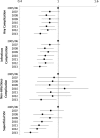National Trends in Short-term Outcomes Following Non-emergent Surgery for Diverticular Disease
- PMID: 27120447
- PMCID: PMC4916196
- DOI: 10.1007/s11605-016-3150-y
National Trends in Short-term Outcomes Following Non-emergent Surgery for Diverticular Disease
Abstract
Introduction: Elective surgery for diverticulitis has evolved over the last decade. We aimed to evaluate the impact of changing practice patterns on postoperative outcomes. We hypothesized that the increased use of laparoscopy, and other management changes, would correlate with a decrease in postoperative complications.
Methods: Patients undergoing non-emergent surgery for diverticulitis from 2005 to 2013 were selected from the National Surgical Quality Improvement Program (NSQIP) database. We compared patient demographics, comorbidities, and operative approach by year of operation using chi-square tests and investigated temporal trends in postoperative outcomes using univariate, trend, and multivariate analyses.
Results: The analytic cohort, which included 29,893 patients, had increasing rates of obesity, advanced age, and higher American Society of Anesthesiologists (ASA) class over the study period. The use of laparoscopy increased significantly from 48 % in 2005/2006 to 70 % in 2013 (p < 0.001), while the rate of stoma creation remained unchanged (10-12 %, p = 0.072). The absolute risk of any postoperative complication decreased by 5.8 % over the study period, driven primarily by a reduction in infectious complications. Year of operation was a significant independent predictor of fewer complications for 2011-2013.
Conclusion: Despite a trend towards increasing patient complexity, there has been a decline in postoperative morbidity following non-emergent surgery for diverticulitis. This trend coincides with the steadily increasing use of laparoscopy in this population.
Keywords: Colectomy; Diverticulitis; Laparoscopy; Outcomes.
Figures







References
-
- Feingold D, Steele SR, Lee S, et al. Practice parameters for the treatment of sigmoid diverticulitis. Dis Colon Rectum. Volume 57. United States, 2014:284–94. - PubMed
MeSH terms
Grants and funding
LinkOut - more resources
Full Text Sources
Other Literature Sources

